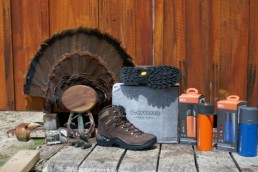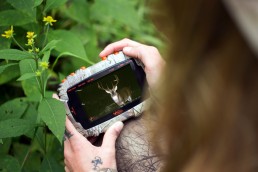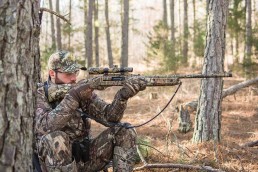Turkey Season Preparation: Time to get Ready
SHARE THIS POST
Scouting matters, and whether you are a novice turkey hunter or veteran, one of the first keys to harvesting a turkey is the time you invest in this step. In most Midwest states, the season opens in the middle of April and runs into or through May. Most of your scouting should be done one to two weeks prior to your hunt. That’s because turkey patterns change at different stages of the spring, and you want your intel to be fresh.
When you start scouting, always keep a set of binoculars readily available and make every effort to be at your destination prior to sunrise. Be on the lookout for birds flying down from their roost and working their way to a feeding ground. Keep a journal of dates and times of turkey movement and you’ll be on your way to understanding their current patterns.
Locating birds is half the battle, and you’ll have conquered that task.
Turkey talk
Effective calling practice starts with a good foundation. With the number of videos posted online, it is clear the number one mistake can come from watching improper calling techniques. Whether it is a pot call or mouth call, hand technique is critical to ensure a successful turkey sound. Shane Simpson, an avid outdoorsman and champion turkey caller, lends a few tips to get you ready for spring.
“The trick,” Simpson says, “is to filter out the good online videos from the bad. One simple way is to look for instructional videos specifically from champion callers. After you have learned the basics to handling a call, then you can move on to practicing the proper sounds you create with that call.”
Dress for the test
Getting your gear ready for turkey season can be a daunting task. Are you a mobile or stationary hunter, or a combination of both? Whatever category or categories you fall into, remember to pack a variety of items so you can adjust to the climate and conditions.
Clothes
Spring brings a mixture of weather conditions, regardless of the state you are in. Be sure to put a lightweight base layer on and pack heavier layers so you can adjust accordingly. If you plan to sit in a blind, all black from the waste up works well. This breaks up your silhouette while in the blind. If you are a mobile hunter, pack a camo rain jacket that has hues of green in the pattern. Face masks are a must in either hunting situation.
Are you enjoying this post?
You can be among the first to get the latest info on where to go, what to use and how to use it!
Decoys
Turkey decoys can make or break your hunt. While scouting, watch the patterns the birds display and try to mimic with a decoy. In the spring, birds mate and their patterns are much different than fall. Typically, using a hen decoy alone can get the big boys ready to trot over. However, if the birds are not heading in the direction of your decoy, pair up a tom with a hen decoy to give real toms a chance to battle over her.
Blinds, bugs
blind that is lightweight and portable can be your best friend when switching locations. The last thing you want to encounter when you hear a big tom gobbling his head off is trouble taking down your blind quickly, and quietly.
As the weather warms up, bugs get busy. Depending on your state and the temperature, make sure you pack bug spray. Unlike when you’re deer hunting, you do not have to worry about scent control.
Choose your weapon wisely
When deciding which weapon to use, think concealment and accuracy. Will you be able to draw back your bow without being seen? Have you patterned your gun lately? Whichever weapon you choose, practice, practice, practice. The last thing you want to do is watch your scouting, calling, and decoy placement plan come together, only to miss the shot.
MWO
SHARE THIS POST
Did you enjoy this post?
You can be among the first to get the latest info on where to go, what to use and how to use it!
Alison Marie
Alison Marie was born and raised in southern Minnesota, where she runs Rack ‘em Guide Service. You can find her in the woods and fields chasing ducks, geese, deer, and turkeys, or on the water fishing. Her day job is at USDA Natural Resources Conservation Service, helping people help the land. She’s President of St. Charles chapter of Whitetails Unlimited.



